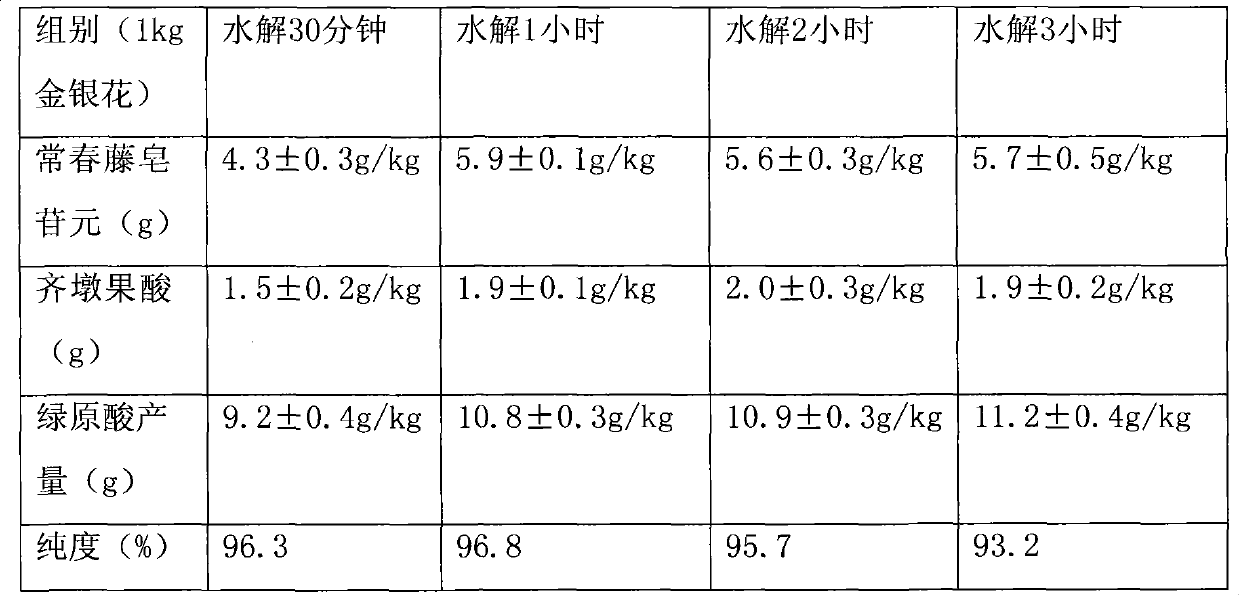Method for extracting saponin compounds from honeysuckle
A honeysuckle and compound technology, which is applied in the pharmaceutical field to achieve the effects of reducing cost, reducing industrial energy consumption and improving utilization rate
- Summary
- Abstract
- Description
- Claims
- Application Information
AI Technical Summary
Problems solved by technology
Method used
Image
Examples
Embodiment 1
[0022] A method for extracting saponins from Flos Lonicerae, comprising the steps of:
[0023] 1) Pulverization: put 1 kg of honeysuckle (Pingyi honeysuckle) into a pulverizer to pulverize, and then spread it into 1 square meter;
[0024] 2) Ultraviolet irradiation: irradiate under ultraviolet light for 10 minutes, and the ultraviolet intensity is 2000uW / cm 2 ;
[0025] 3) Hydrolysis: use deionized water 8 times the weight of honeysuckle as a solvent, maintain at 0.1 atmosphere, hydrolyze at 75°C for 1 hour, and collect the filtrate;
[0026] 4) concentration: the filtrate is placed in a vacuum concentrator, and vacuum concentrated to one-third of the volume of the filtrate;
[0027] 5) Precipitation: add a calculated amount of alcohol so that the alcohol content in the concentrated solution reaches 75% (v / v), and after standing for 1 hour, the chlorogenic acid is completely precipitated, and the filtrate and precipitate are collected by filtration;
[0028] 6) Drying: the ...
Embodiment 2
[0032] A method for extracting saponins from Flos Lonicerae, comprising the steps of:
[0033] 1) Crushing: put 1 kg of honeysuckle into a pulverizer to pulverize, and then flatten it into 1 square meter;
[0034] 2) UV irradiation: UV irradiation for 15 minutes, the UV intensity is 2000uW / cm 2 ;
[0035] 3) Hydrolysis: use deionized water 10 times the weight of honeysuckle as a solvent, maintain a state of 0.1 atmosphere, hydrolyze at 75°C for 1 hour, and collect the filtrate;
[0036] 4) concentration: the filtrate is placed in a vacuum concentrator, and vacuum concentrated to one-third of the volume of the filtrate;
[0037] 5) Precipitation: add a calculated amount of alcohol so that the alcohol content in the concentrated solution reaches 75% (v / v), and after standing for 1 hour, the chlorogenic acid is completely precipitated, and the filtrate and precipitate are collected by filtration;
[0038] 6) Drying: the precipitate was vacuum-dried at 80°C to obtain chlorogeni...
Embodiment 3
[0042] Effects of various factors on the extraction efficiency of saponins and chlorogenic acid
[0043] 1. The influence of ultraviolet irradiation intensity and time, control other conditions unchanged, only change the ultraviolet irradiation parameters, repeat the experiment three times for each group, see Table 1 for specific results
[0044] Table 1
[0045]
[0046] Conclusion: Through analysis, it is found that ultraviolet irradiation can greatly increase the yield of saponins and chlorogenic acid, but with the increase of time, the purity of chlorogenic acid is greatly reduced, which may be due to the decomposition of chlorogenic acid caused by strong light. Little effect on saponins.
[0047] 2. Effect of hydrolysis time on the yield of saponins and chlorogenic acid
[0048] Change the time of hydrolysis, control other conditions unchanged, repeat each group of experiments three times, see Table 2 for specific results
[0049] Table 2
[0050]
[0051] Concl...
PUM
 Login to View More
Login to View More Abstract
Description
Claims
Application Information
 Login to View More
Login to View More - R&D
- Intellectual Property
- Life Sciences
- Materials
- Tech Scout
- Unparalleled Data Quality
- Higher Quality Content
- 60% Fewer Hallucinations
Browse by: Latest US Patents, China's latest patents, Technical Efficacy Thesaurus, Application Domain, Technology Topic, Popular Technical Reports.
© 2025 PatSnap. All rights reserved.Legal|Privacy policy|Modern Slavery Act Transparency Statement|Sitemap|About US| Contact US: help@patsnap.com


